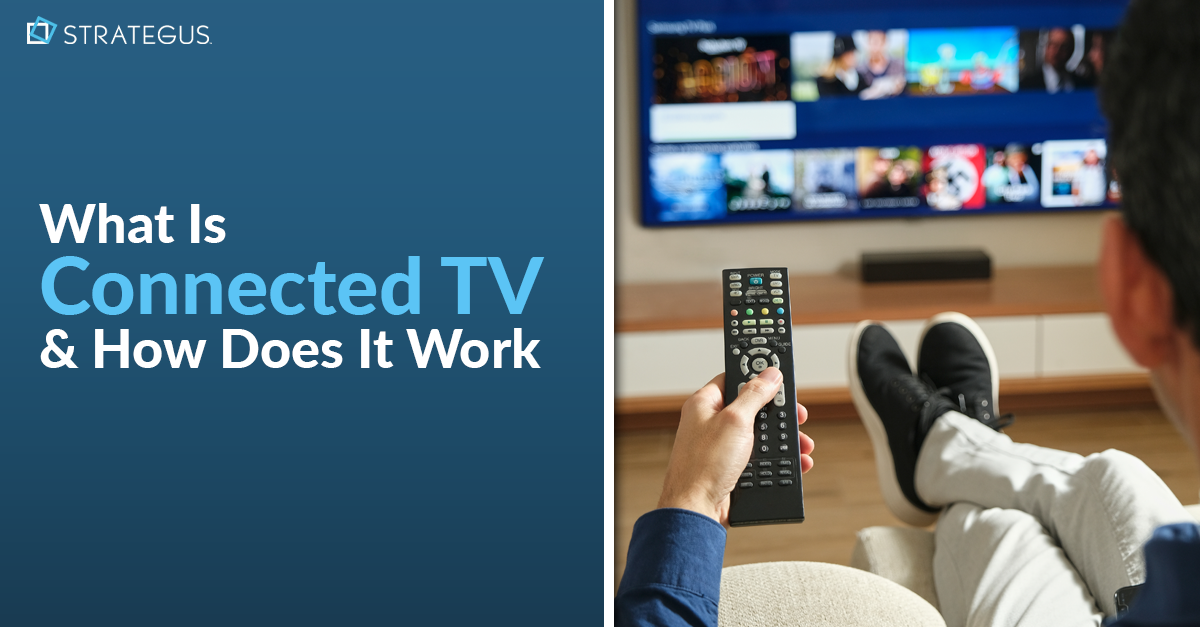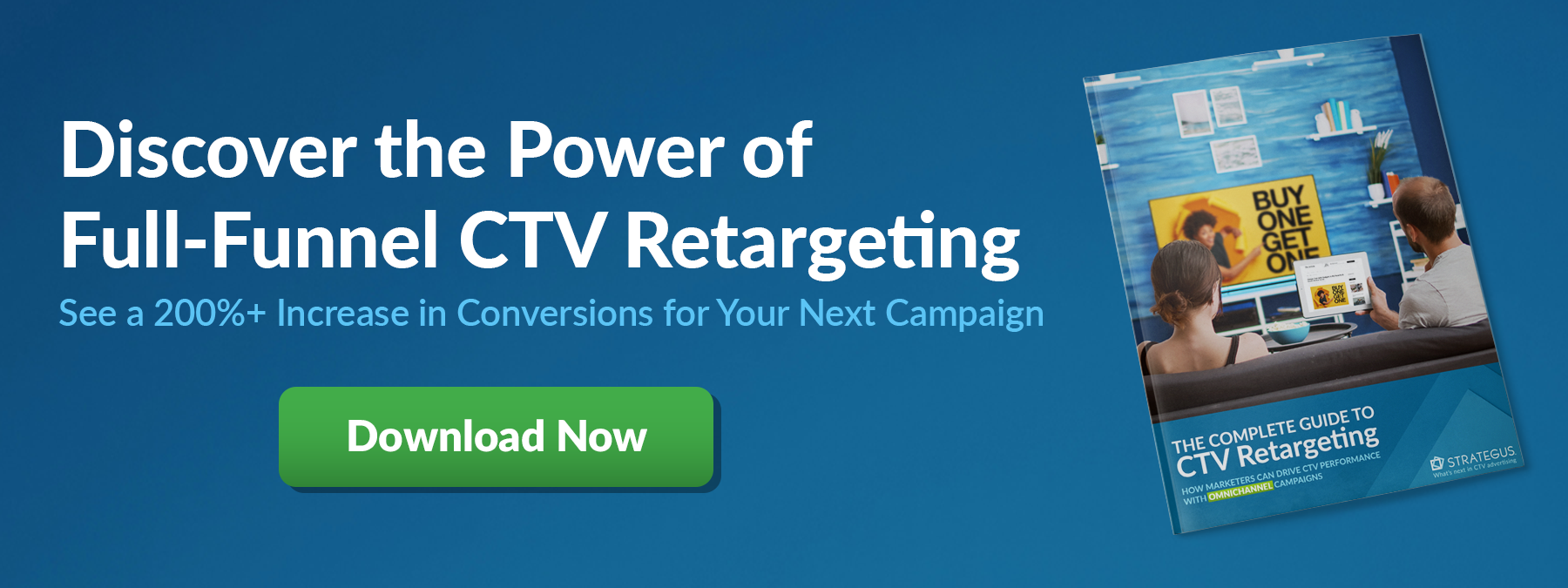- Home
- Strategus Blog
- CTV Advertising: What Is Connected TV and How Does It Work
CTV Advertising: What Is Connected TV and How Does It Work
 Traci Ruether
Traci Ruether
23 minutes read

Connected TV (CTV) advertising describes the ads served to viewers tuning into streaming content on internet-connected television sets.
Unlike traditional commercials, these ads can target individual viewers based on their interests, browsing activity, lifestyle choices, and more. CTV ads can also be measured and tracked in real time, transforming the living room television into a powerful digital marketing channel.
In this guide to CTV advertising, we cover everything you need to know — including how programmatic CTV works, industry trends, the benefits of advertising on connected TV, and strategies to drive results.
But first, let’s look at the basic definitions.
What Is Connected TV?
Connected TV refers to any internet-connected television used to stream video content on services like Amazon Prime. Some common CTV devices include:
- Smart TVs like the Samsung OLED, which come with an operating system and preloaded apps.
- Set-top boxes or streaming devices like Roku that transform ‘dumb’ TVs into internet-connected devices that can access streaming content.
- Gaming consoles like the Xbox that allow users to stream movies, TV shows, and music in addition to playing video games.
%20devices.png?width=800&height=362&name=connected%20tv%20(CTV)%20devices.png)
What Is Connected TV Advertising?
CTV advertising, by extension, describes the ads served to viewers using these devices to stream. Because CTV ads are delivered digitally, they offer several advantages over traditional commercials:
- Precise Audience Targeting: Reach specific demographics, interests, and viewing habits.
- Real Time TV Measurement: Track ad impressions, clicks, and conversions in real time.
- Cross-Device Retargeting: Re-engage viewers who have previously interacted with your brand online.
- Holistic Attribution: Gain a comprehensive understanding of how your CTV campaigns contribute to overall marketing goals.
As such, media buyers placing ads on CTV gain the ability to pinpoint relevant buyers and track viewer activity following exposure. This paves the way for more data-driven and personalized campaigns that drive business results.
OTT Advertising vs. CTV Advertising
CTV and OTT (short for over-the-top) are often used interchangeably, but a key distinction exists between the two:
- OTT refers to the delivery method (streaming video over the internet).
- CTV refers to the devices used to access OTT content (smart TVs, streaming devices, etc.).

CTV is thus a more premium subset of OTT that focuses on big-screen TVs where co-viewing is more common (resulting in more ad impressions) and viewers are more engaged.
Media buyers need to understand this distinction. After all, a YouTube ad that plays while a user listens to music videos on their mobile device is not as valuable as a commercial that airs during a live broadcast of the Olympics.
Here’s a full breakdown of CTV and OTT:
| Over-The-Top (OTT) | Connected TV (CTV) |
|
| Definition | Traditional TV ads are purchased from publishers based on the channels and shows being broadcast on scheduled linear channels. | Devices that connect to the internet to access streaming content. |
| Access Devices | Broadcast over scheduled linear TV channels. | Big-screen devices like smart TVs, set-top boxes, gaming consoles. |
| Content Sources | Live TV or pre-recorded shows on local networks and MPVDs | Premium OTT streaming platforms accessed on TV screens (rather than laptops, mobile phones, etc.). |
| Advertising Format | Within designated commercial breaks during TV programming. | Advertisements served on TV screens during streaming content. |
| Targeting Options | Limited options based on general demographics and viewership. | Similar to OTT but with additional insight based on TV-viewing behaviors. |
| Example | Insufficient data on ad performance and attribution. |
The Roku channel viewed on a Roku TV. |
Read our full post on OTT vs. CTV →
Why CTV Is the Future of TV Advertising
Streaming TV adoption grows each year, with the average U.S. adult spending more than 123 minutes per day tuning into CTV.
Up until recently, live sports broadcasting has kept legacy TV alive. But that’s all changing. Tech-backed streaming services like YouTube TV, Amazon Prime, and Netflix are now outbidding traditional media outlets for sports broadcast rights — prompting even more viewers to cut the cord.
Meanwhile, ad-supported streaming has also become the norm, bringing more premium inventory for advertisers looking to reach engaged viewers on the biggest screen in the household. Netflix, Disney Plus, and Max all now offer ad-supported tiers, while FAST services like Tubi and the Roku Channel rely entirely on ads to generate revenue.
Viewers have already moved to streaming. And the most sought-after content in TV advertising — live sports — is now migrating with them. For this reason, CTV ad spending is growing each year, while investment in linear TV advertising is steadily declining.

Media Universe Cartographer Evan Shapiro explains:
“Media buyers are moving money away from non-digital platforms, where they are far more certain about the return on their marketing investment (ROMI). And, that movement is accelerating…
This was already happening before the writers union shut down TV. But, when you add the strike, mix in the subscription apocalypse, sprinkle on the rise of FAST, add a dash of Bob Iger floating ESPN and Disney for sale, knead in YouTube’s acquisition of NFL Sunday Ticket, and bake it all at 450 degrees of shitty-ass measurement… You get a perfect recipe for the death of traditional media as we know it.”
Read our full report on The Future of TV: How Advertisers Can Prepare for a Converged Landscape →
Benefits of CTV Advertising

CTV offers all the benefits of TV advertising, combined with the precision targeting and measurement of digital mediums. Here are some of the many advantages of placing ads on streaming TV. Here’s a look at the key advantages.

Hypertargeted and Localized
When running programmatic CTV campaigns, marketers can target specific audience segments. This replaces the spray-and-pray approach of linear TV with a much more precise strategy.
CTV targeting can take many different forms. At Strategus, we’re proponents of layering first- and third-party data sources to build custom audiences for each campaign.
Check out our CTV targeting deep dive to learn more→

Personalized and Relevant
In this way, CTV allows brands to reach the right people, at the right time, with the right message by customizing their creative based on which customer segments are being targeted.
Say a tourism board was running campaigns to three key customer segments: ski and snowboard enthusiasts, outdoor adventurers, and luxury travelers.
The ad creative could be personalized as follows:
- Ski and Snowboard Enthusiasts: For this segment, the ad could showcase the most well-known ski resorts with an early bird promo for lift tickets.
- Outdoor Adventurers: These ads might combine shots of breathtaking hikes, pristine lakes, and idyllic camping locations, with a call to action (CTA) directing users to the website for more information.
- Luxury Seekers: For this segment, the creative could focus on luxury spas, gourmet dining experiences, five-star hotels, and exclusive VIP deals.
The result is more relevant and actionable ads on the biggest screen in the house.

Omnichannel Retargeting
Because CTV ads run in digital environments, advertisers can re-engage the same users on other devices through cross-device retargeting. For instance, the tourism campaign above could follow up with the same viewers by incorporating additional touchpoints via online video ads on YouTube, streaming audio ads on Spotify, and social media ads on Instagram.
This type of full-funnel advertising isn’t common in CTV, but it’s a core part of how we approach it at Strategus. More specifically, we use deterministic matching to retarget prospects across the entire programmatic ecosystem. This method relies on precise identifiers from our identity graph partners, thus ensuring that retargeting efforts are focused on users who’ve previously seen a brand’s CTV ad.

Cost-Effective and High-Performing
With CTV, media buyers only pay for ads that reach their desired audience. This eliminates wasteful ad impressions served to the wrong viewers — all while boosting performance with more relevant experiences.
Strategus Co-Founder Joel Cox explains:
“Programmatic advertising brings new capabilities to more mid-market companies who can now afford more precise targeting, and therefore more accessible budgeting and reach. The opportunities for more advertisers are democratized by new technology.
We want to move the market more toward where it should go, where ads are targeted to individuals in the audience, who see ads that are relevant to them, as opposed to the old way, where ads are targeted more toward the content that people are watching. The data-driven approach makes so much more sense as the content is exploding with digital streaming over the internet. Serving relevant ads to the right people at the right time is where the advertising industry has wanted to go for generations.”

Real-Time Measurement and Multi-Touch Attribution
The digital nature of CTV gives marketers access to a ton of data. This allows brands and agencies to tie marketing dollars to quantifiable outcomes by gaining insight into how many people made online purchases, visited a brick-and-mortar location, or researched the advertised products following ad exposure.
Need a concrete example? Let’s take a case study from the University of Washington.
The school’s marketing team partnered with Strategus to drive ticket sales for their men’s basketball and football teams. In addition to generating $296,000 in revenue from the campaign, they gained better insight than was previously possible.
Brian Bowsher, the associate athletic director, explains:
“It was always hard to track the impact of our ads that ran on ESPN or NBC Nightly News. Working with Strategus, we’re now able to report data showing how many people saw our spots, how many took the next step and went to our website, and what percentage of those engagements resulted in transactions. This has really helped quantify our ROI.”

Big-Screen, Multimedia Impact
Many of the advantages above can be attributed to CTV’s digital nature. But CTV also has something that other digital channels lack: Big-screen delivery to hyper-engaged viewers.
With sight, sound, and motion, CTV ads make a more memorable impact than static display ads or skippable YouTube ads. This is all the more true when they run during live or premium content like a sporting event or a season premiere.

Ongoing Optimization
CTV advertising is dynamic and can be changed on a dime. While a “set it and forget it” mentality leads to missed opportunities, taking a more proactive approach can help brands nail down a formula for success through iteration.
In-depth metrics about engagement and conversions also enable marketers to run tests and continuously optimize their campaigns. Obviously, this requires time and resources that not all marketers have. But there’s always the option to enlist the help of a managed services partner like Strategus to take care of the day-to-day details of maximizing CTV success.
How to Buy CTV Ads
CTV ad inventory can be purchased in a few different ways, including via direct sales, through a self-serve DSP, or by partnering with a managed service provider like Strategus.
While directly purchasing ad space takes a more content-specific approach akin to legacy TV, programmatic ad-buying with either a DSP or managed services provider allows media buyers to place ads on a per-viewer basis. Almost 90% of CTV buys are transacted programmatically today due to the benefits of programmatic placement.
Here’s a closer look at each category:
| Direct Sales |
Self-Service DSP | Managed CTV Services |
| • Direct sale of ad space from content or app owners bought via a lengthy hands-on process. • Inventory is limited to the publisher’s owned properties. • Measurement is determined by the individual platform. • Cross-publisher control becomes a challenge. • Manual, inefficient process. • Purchased as a sponsorship or direct insertion order. |
|
• Campaign planning and execution is outsourced to a team of experts who transact programmatically across multiple publishers and DSPs. • Integration with data partners and publishers ensures hyper-targeting at scale. • Personalized guidance and hands-on execution minimize the burden on your team • Measurement across different platforms is consolidated into a single dashboard. |

How Does Programmatic CTV Work?
If you go with a DSP or managed service provider like Strategus, your ads will be placed programmatically via a real-time bidding. The process can be summarized in five steps.
- A user settles in for their favorite show on a streaming app like Hulu, Tubi, or YouTube TV.
- The app sends a bid request to a supply-side platform (SSP) looking for advertisers to compete for the ad spot. The request includes information about the user’s digital footprint, such as their viewing habits, demographics, location, and more.
- An ad exchange connects the SSP with demand-side platforms (DSPs) to centralize and automate media buying across multiple sources.
- A DSP or an ad network connects advertisers to the exchange, allowing them to set parameters for how they target ads, and then make purchases via real-time bidding.
- In a split second, the highest bidder wins the ad slot, and the viewer is served a relevant commercial without any noticeable lag.
And while it sounds simple enough, don’t let this explanation lead you astray. The CTV ecosystem grows in complexity each day — with countless ad networks, DSPs, ad exchanges, and more vying for media buyers’ attention.
Strategus President Todd Porch explains:
How Connected TV Audiences Are Targeted

CTV targeting will vary depending on what your ad tech stack looks like. Some DSPs still use rather fundamental data sources to build generic segments. Likewise, your data will be limited if you’re pacing ads via direct sales.
At Strategus, though, we take a layered approach to targeting that incorporates multiple data sources to maximize results. Rather than providing off-the-shelf audience segments, we work with agencies and brands to build custom audiences based on a mix of tactics.
Our targeting methods include:
 Website Retargeting: Reengage warm leads on the big screen and lure online shopper back to their abandoned carts. This keeps your brand top of mind after leads step away from the computer.
Website Retargeting: Reengage warm leads on the big screen and lure online shopper back to their abandoned carts. This keeps your brand top of mind after leads step away from the computer.
 First-Party Data: Leverage customer data from your CRM to deliver personalized CTV ads directly to your contacts’ living rooms.
First-Party Data: Leverage customer data from your CRM to deliver personalized CTV ads directly to your contacts’ living rooms.  Lookalike Modeling: Expand your reach by building custom lookalike audiences. This powerful tactic is our second-best performer for driving results.
Lookalike Modeling: Expand your reach by building custom lookalike audiences. This powerful tactic is our second-best performer for driving results.
 Location-Based Retargeting: Reconnect with users who‘ve visited your stores — or conquest foot traffic from competitor locations. Both are powerful tactics to translate physical touchpoints into digital engagement.
Location-Based Retargeting: Reconnect with users who‘ve visited your stores — or conquest foot traffic from competitor locations. Both are powerful tactics to translate physical touchpoints into digital engagement.
 Smart Audience Contextual: Reach consumers actively researching your services by targeting viewers based on the websites they’ve been visiting and keywords they’ve been typing into Google.
Smart Audience Contextual: Reach consumers actively researching your services by targeting viewers based on the websites they’ve been visiting and keywords they’ve been typing into Google.
 ACR Data Targeting: Reach specific households based on their TV viewing habits and interests for precise audience alignment. This could mean showing an ad for a Lexus convertible on its way to a golf course to a viewer who regularly watches live golf.
ACR Data Targeting: Reach specific households based on their TV viewing habits and interests for precise audience alignment. This could mean showing an ad for a Lexus convertible on its way to a golf course to a viewer who regularly watches live golf.
 Linear TV Extension: Bridge the gap between your linear TV campaigns and CTV by targeting households exposed to your TV ads for increased reach and frequency. A combination of both mediums ensures that your efforts aren’t siloed.
Linear TV Extension: Bridge the gap between your linear TV campaigns and CTV by targeting households exposed to your TV ads for increased reach and frequency. A combination of both mediums ensures that your efforts aren’t siloed.
 Amazon Data Targeting: Leverage Amazon purchase data to reach consumers actively shopping for products related to your campaign. For instance, a person who often purchases gluten-free products may see a commercial for a local health store.
Amazon Data Targeting: Leverage Amazon purchase data to reach consumers actively shopping for products related to your campaign. For instance, a person who often purchases gluten-free products may see a commercial for a local health store.
Why Choose Strategus as Your CTV Partner

With Strategus as your partner, you get the broad reach, data integrations, and expertise required to drive CTV results. Our combination of premium inventory and data-driven targeting ensures precise ad placement focused on your viewers, thus maximizing campaign results.
Some other advantages of working with us include:
Big Screen Focus
Our CTV-first strategy captures your audience’s attention on the largest screen in the household. Sight, sound, and motion bring your brand to life in a way that no other marketing channel can recreate.
Cross-Device Retargeting
We keep your audience connected across every screen by re-engaging them with follow-up ads across other devices, reinforcing your message and driving conversions.
Data-Driven Strategies
Our ecosystem of 200+ data providers ensures targeting and attribution like never before, enabling us to develop informed strategies and adapt on the fly based on what the data reveals.
Multi-Publisher Control to Manage Frequency
As a vendor-agnostic partner, we make it easy to reach your audience no matter what they’re tuning into — while also capping frequency and conducting measurements across the entire OTT ecosystem.
CTV Marketing Best Practices for Driving Leads
CTV advertising sits at the intersection of linear TV and digital advertising, allowing marketers to reach engaged viewers in a targeted and measurable way. But you still need to approach it strategically to drive results
We’d recommend prioritizing the following best practices when getting started.
- Define campaign goals and target audiences: The first step to crafting a CTV campaign is defining your goals (e.g., brand awareness, website visits, foot traffic to a brick-and-mortal location) and target audience segments. This will lay a foundation for more targeted and actionable campaigns.
- Gather existing video assets: Next, assess your existing video library. Look for high-quality, on-brand content that aligns with CTV's technical requirements. This includes professional production value, clear branding throughout, a singular focus on a key message, and clean design with easy-to-read text and contrasting colors for optimal viewing on large screens.
- Update what you have or build CTV-first creative: Whether you’re updating existing video assets or creating new ads from scratch, it’s all about giving users a clear call to action based on your campaign goals. Some tactics for doing this include promoting current deals, showcasing your current inventory with dynamic creative, or incorporating interactive elements like QR codes that drive action.
- Personalize messaging to different audiences: The key to CTV advertising is delivering relevant ads that resonate with viewers. As such, tailoring ad creative to different buyers drives better results. This could mean swapping out the B-roll or highlighting different products and services.
- Nail the basic requirements and specs: Align with technical specs for the length (15 or 30 seconds), file format (MP4), and resolution (1080 p). Failure to meet these specs can cause latency and buffering, potentially causing viewers to abandon the app or even reboot their devices.
- Put guardrails in place to prevent ad fatigue: Rotate at least 3 creative variations can help prevent ad fatigue, as well as refreshing your ads quarterly. You’ll also want to monitor campaign frequency and engagement to adjust your strategy based on what the data shows.
- Integrate your CTV ads into full-funnel campaigns: Expand your reach and boost conversions by layering retargeting efforts across various channels like display ads, paid social media ads, and paid search ads. This allows you to deliver targeted messages throughout the customer journey, from initial brand awareness to website visits and ultimately, conversions.
- Test and optimize campaigns in flight: Just like other digital channels, CTV campaigns should be monitored and optimized on an ongoing basis.
Check out our Guide to CTV Best Practices for more details.
Conclusion
Abiding by all the best practices above requires a hands-on approach and integrations across the CTV ecosystem. For this reason, many brands and agencies choose to enlist the help of a managed services partner like Strategus to take care of all the moving parts.
We ran the first programmatic CTV ad in 2015 and continue to push the boundaries. What’s more, we take a hands-on approach — getting to know you, your brand, your goals, and your audience.
The results speak for themselves, which is why we have countless real-world success stories of agencies and brands that have worked with us to turn connected TV into a performance marketing channel.
Find out what our cutting-edge capabilities and dedicated team of CTV experts can do for you. Contact us today to get started.

Traci Ruether is a content marketing consultant specializing in video tech. With over a decade of experience leading content strategy, she takes a metrics-driven approach to storytelling that drives traffic to her clients' websites. Follow her on LinkedIn at linkedin.com/in/traci-ruether or learn more at traciruether.com.
Strategus is a managed services connected TV(CTV) advertising agency with over 60,000+ campaigns delivered. Find out how our experts can extend your team and drive the result that matter most.
Talk to an Expert
Table of Contents
- What Is Connected TV?
- What Is Connected TV Advertising?
- OTT Advertising vs. CTV Advertising
- Why CTV Is the Future of TV Advertising
- Benefits of CTV Advertising
- How to Buy CTV Ads
- How Does Programmatic CTV Work?
- How Connected TV Audiences Are Targeted
- Why Choose Strategus as Your CTV Partner
- CTV Marketing Best Practices for Driving Leads
Seeking a Custom CTV Strategy That Delivers?
What to read next

Third-Party Data Targeting for CTV: Benefits & Tactics
Third-party data. It’s a term that’s thrown around, and yet few take the time to detail its pros and cons — much less strategies for using...
7 minutes read

First-Party Data Targeting: Benefits and Tactics for CTV Advertising
First-party data is the information that companies collect directly from their customers rather than through intermediaries. Advertisers use this...
10 minutes read

Foot-Traffic Attribution: Tying Ad Impressions to In-Store Visits
The marketing funnel has changed. Today’s shoppers often begin researching products from the comfort of their homes and don’t set foot into a store...
8 minutes read

CTV Attribution: What It Is and How It Works
Connected TV (CTV) viewing is on the rise — and that’s good news for marketers. Not only can CTV ads be precisely targeted to individual households,...
9 minutes read





















